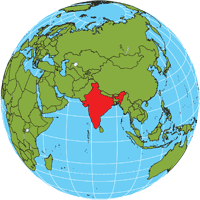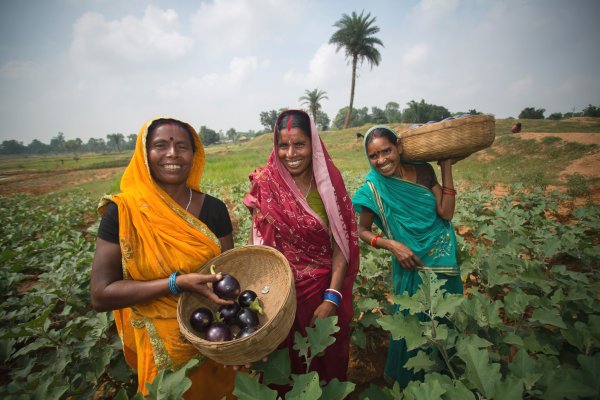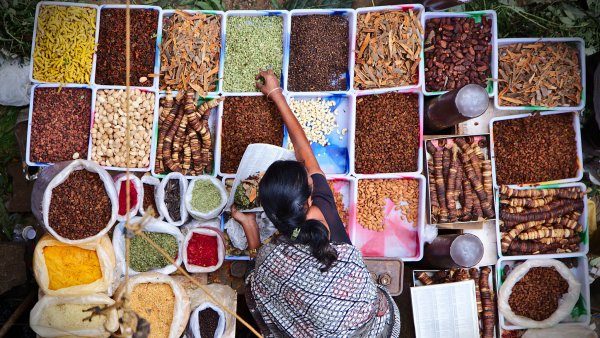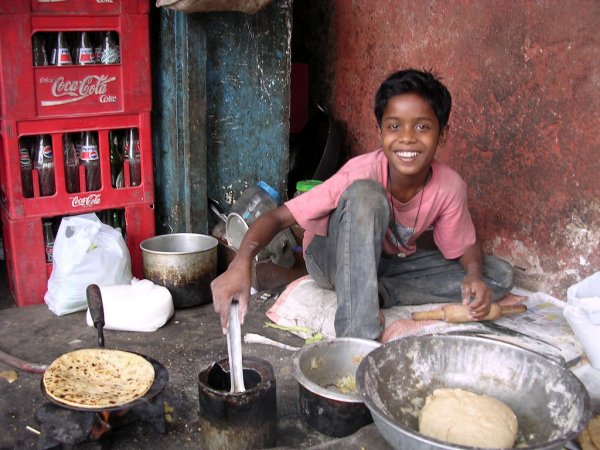Food and Drink: National Cuisine
Indian cuisine varies widely by region and religion; although the spicy stews known as curries that originated in India remain a cornerstone of its cuisine. Northern Indians eat their curries with baked flatbreads (roti or naan), while those in Southern India and Bengal prefer rice and fried breads (paratha, chapati, dosa, appam, and puri). Sauces tend to be richer in the North where they’re often full of fruits and nuts, reflecting the Mughal influence. In the South, sauces are generally spicier and more likely to contain tamarind and coconut. Goat meat is more popular in the North, and fish dishes are especially popular in Kerala and Bengal.
Common Fare
Chicken is widely popular, as in one of India’s best-known dishes, tandoori chicken. A whole chicken or pieces are marinated in yogurt and spices before being baked it in a clay oven called a tandoor (the style is called tikka when bite-size chunks of meat are used). Muslims don’t eat pork, Hindus don’t eat beef, and many Hindus, Buddhists, and Jains are vegetarians.
Lentil and bean dishes (generally called dal) are some of the most common fare, eaten across the country with rice or bread. Dairy products are widely consumed. A simple cheese called paneer is used in many dishes, as well as yogurt which also is found in marinades, raitas, and as the main ingredient in lassi drinks.
Spice Blends
The spice blends typical of Indian cooking are what make it unique. They can include coriander, cumin (jeera), cayenne, turmeric, pepper, salt, black mustard seed, asafetida (a foul-smelling flavor enhancer also known as hing), ginger, and dried mango powder. In Bengal, mustard is extremely popular and lends a distinct flavor to many dishes. Goan vindaloo dishes reflect the rich array of spices available to the state’s former Portuguese traders, especially cloves and cinnamon, although Western versions tend to focus on the dish’s chili heat.
A typical Indian dinner serves a curry atop a pile of steamed rice for the main course with a variety of side dishes. Most common are chutneys and pickles, made from a diverse range of ingredients including green mangoes, preserved lime peel, mint, green or red chilies, tamarind paste, tomatoes, coriander, garlic, and onions. Meals usually include bread, either leavened and clay-oven baked or unleavened and cooked on a griddle.
Indian desserts are numerous and include milk-based barfi, chickpea flour or semolina laddus, milk balls soaked in sugar syrups (jamun, pera, rasagolla), coils of deep-fried batter soaked in sugar syrup (jalebis), rich fruit and nut sweets (halwa), and ice cream made with nuts and spices (kulfi).
Alcohol is prohibited in most of India’s states, although regional-specific traditions of wine and beer-making exist. The Mising and Adi tribes of northern India make a rice beer called apong, palm wines are made in Andrah Pradesh, and in Madhya Pradesh an alcohol is made from flowers.
Copyright © 1993—2024 World Trade Press. All rights reserved.

 India
India 


